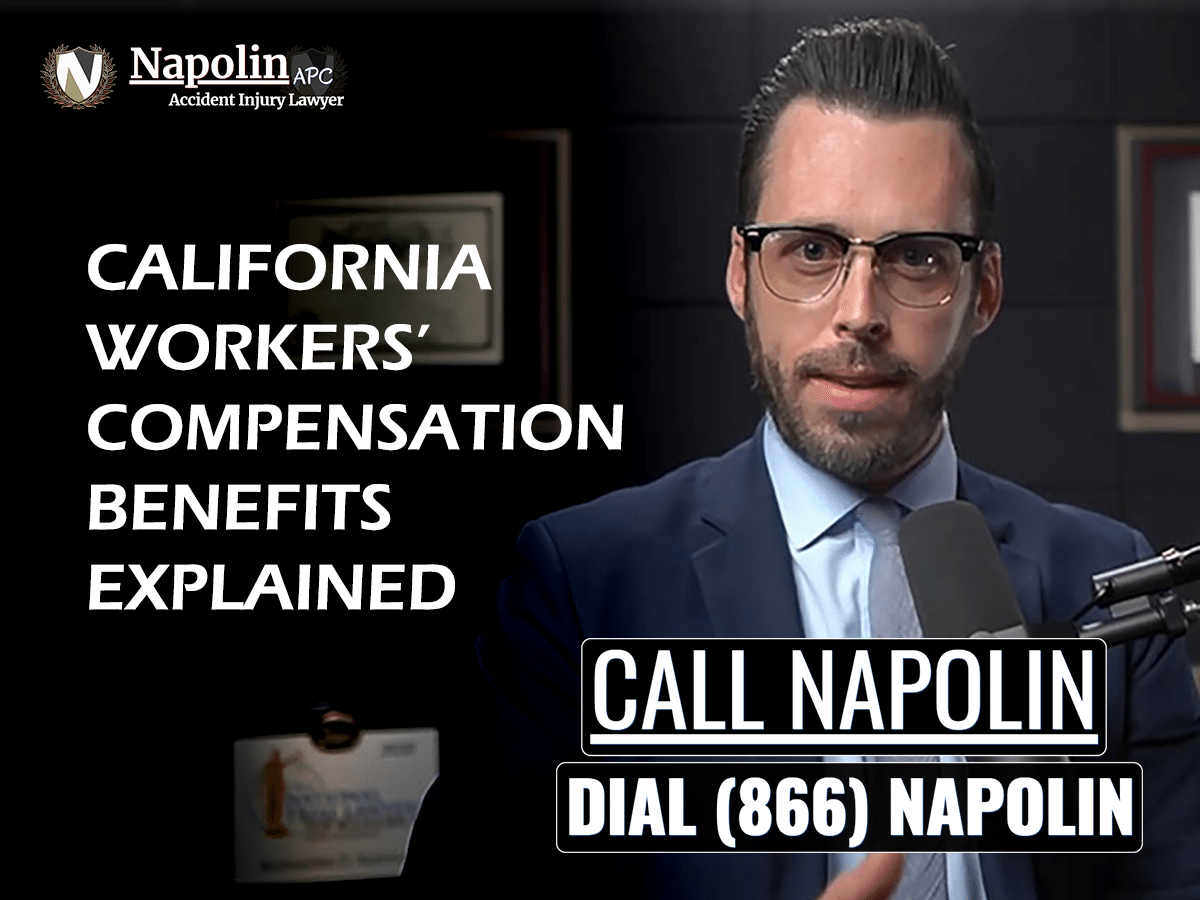California Workers' Compensation Benefits Explained [2022]
Benefits of California Workers' Compensation Law [2022]
California workers' compensation law provides these main benefits in 2022:
Medical benefits to treat the injury.
Temporary disability payment to make up for lost wages due to missing work.
Permanent disability payment for any permanent loss of function;
Rehabilitation and retraining voucher for job displacement due to permanent disability.
Death benefit to the dependents of a worker whose death was caused by work.

The Official California Workers' Comp. Benefits Explained
If your workers' compensation claim is denied, then you are provided with no benefits and need to hire a lawyer. If it is accepted, then you may want to maximize these benefits by hiring a California workers compensation lawyer. In California, injured workers can hire a lawyer and file an Application for Adjudication of Claim to fight for these benefits at the Workers' Compensation Appeals Board (WCAB).
The employer has 90 days from the allegation of injury to accept or deny liability for a workers comp claim. This is known as the delay period and it ends at 90 days or when the employer denies the claim, whichever comes first. During the delay period the employee has a right to timely medical treatment up to $10,000.00. Every employer has a duty to conduct a reasonable and good faith investigation to determine whether benefits are due to the employee.
A failure to pay benefits on time could result in penalties against the employer.1
Napolin is a workers' compensation lawyer available to discuss your specific situation and legal rights over the phone. Want to learn more about what you might be missing? More California workers' compensation benefits explained in detail below. This article is up to date for 2022.
California Work Injury Lawyer
FREE CASE EVALUATION

Have you been injured at work? You should know your rights under California workers' compensation law! In this article you will find the California workers' compensation benefits explained. - Alexander D. Napolin, Esq.
 Medical Benefits
Medical Benefits
First Aid Does Not Trigger A Workers Comp Claim
Injuries requiring only first aid do not trigger workers' compensation claims. First aid is for minor scratches, cuts, burns, or splinters, that require one-time treatment with minimal follow up.2
No further benefits are provided by the employer beyond the cost of the first aid treatment and minimal follow up care. For more information on what constitutes a work-related injury, please read and bookmark What Injury Types Qualify for Workers' Compensation.
Emergency Healthcare Services Paid by the Employer
Employees injured at work have the absolute right to seek emergency medical treatment at the employers expense. Employers have a corresponding affirmative duty to help the employee procure emergency care and authorize treatment.3
Medical Treatment to Cure and Relieve Effects of Injury
Workers are entitled to medical treatment to cure and relieve work injuries.4 The employer has a duty to provide care proactively which it authorizes and pays for as the claim progresses.
The injured worker usually selects a doctor within the employer's Medical Provider Network (MPN). Read our legal blog for more in-depth information about how to select a workers compensation doctor. The insurance company reviews all treatment requests for reasonableness and medical necessity.56 Disputes often arise when the adjuster denies treatment by Utilization Review (UR).
Transportation Expenses to Medical Appointments
Transportation, meals, and lodging reasonably required to attend medical appointments and fill prescriptions.7 The current mileage reimbursement form rate is $0.58.5 per mile. If the injured worker cannot drive, then the employer is required to provide Medical Transport Services to and from medical appointments.
Interpreting Services for Medical Examinations
Injured workers are entitled to have a court certified interpreter for medical appointments at their employers expense.
Nursing Services and Personal Attendant Care For Severe Injury Situations
If an injured worker is unable to care for themselves, then they may be entitled to regular nursing care to include general housekeeping, driving, shopping and cooking services. An adjusters failure to help an injured worker obtain home health care could subject the employer to sanctions.
 Temporary Disability Benefit
Temporary Disability Benefit
Temporary disability payments replace lost wages due to missed time from work while recovering from an industrial injury. To qualify, the primary treating physician (PTP) reports work restrictions that the employer cannot accommodate with modified duties.
Payments continue for 1) up to 104 weeks; or 2) until the injured worker is deemed able to return to work; or 3) reaches Maximum Medical Improvement (MMI). Payments are made in the form of a check and mailed to the employee or their designated agent.89
Extension of Temporary Disability to 240 Weeks
Some types of industrial injuries qualify for double the temporary disability limitations period from 104 to 240 weeks. These include: 1) acute and chronic hepatitis B; 2) acute and chronic hepatitis C; 3) amputations; 4) server burns; 5) HIV; 6) high-velocity eye injury; 7) chemical burns to the eyes; 8) pulmonary fibrosis; or 9) chronic lung disease.10
3-Day Waiting Period
An injured worker cannot collect temporary disability payments for the first three days missed from work. The 3-day waiting period is waived where the injured worker is disabled for more than 14 days or where they are admitted to a hospital with the expectation of occupying a bed overnight.1112
Calculating the Compensation Rate
The compensation rate for temporary total disability is 2/3 of the employee's average weekly earnings.13 Starting January 1, 2022, the maximum weekly rate of temporary total disability will be $1,539.71 per week.
First, identify the average weekly wage by adding up the gross pay of all available pay stubs. Second, multiple that figure by 2/3 to obtain the weekly temporary disability reimbursement rate not to exceed $1,539.71.14
Temporary Partial Disability Rate Calculation
Temporary Partial Disability (TPD) happens when the employee is capable of performing some work, but not full normal duties during the healing period. The TBD compensation rate is calculated the same way as the TTD rate. The amount paid to the claimant depends on their average weekly wage and hours missed due to the work restrictions from their Primary Treating Physician.
First, identify the average weekly wage by adding up the gross pay on all available pay stubs. Second, subtract the amount of wages earned by the employee during the applicable period. Multiple what's left by 2/3.
Penalties for Late Payments
Your employer may owe you an automatic 10% penalty if your check is sent late.15 However, you must have already filed a DWC-1 Claim Form to be awarded penalties under Labor Code § 4650. Speak with a lawyer about the specifics of your case to determine your entitlement to penalties.
Banking holds between 3-10 days in accordance with state and federal banking regulations are not considered delayed under California Law.
Deductions For Child Support
When in receipt of a proper court order, employers are required to deduct child support from temporary disability benefits.16 The only way for the claimant to challenge the order is by petition to the Superior Court to change or reduce the ongoing obligation.
 Permanent Disability Benefit
Permanent Disability Benefit
An injured worker receives permanent disability payments once their work injury reaches Maximum Medical Improvement (MMI). Also called Permanent and Stationary (P&S), it means the condition is well stabilized, and unlikely to change substantially in the next year with or without medical treatment.17 At this time, temporary disability benefits end (unless returned to work beforehand) and permanent disability benefits begin.
In theory, the permanent disability rating system approximates decreased earning capacity. It does not compensate the injured worker for their actual loss of future earnings. The permanent disability benefit is indicated when the PTP issues a final medical report (PR-4) finding the patient P&S and providing a WPI rating. Both the injured worker and the insurance adjuster have the right to challenge the PTP and request a Med-Legal Evaluation with a Qualified Medical Evaluation (QME).18
Calculating Permanent Disability Benefits
Permanent Disability Rating
The PTP and/or QME issue a final medical report with a Whole Personal Impairment (WPI) using the AMA Guides to the Evaluation of Permanent Impairment (5th Edition).19 These guide the doctor to assign a percentage of disability to each damaged body part or system, which add up to a final percentage or WPI between 1-100.
Like WPI, the Permanent Disability Rating is also expressed as a percentage between 1-100 and is calculated by multiplying the WPI rating by 1.4 and then modifying it for occupation, age and earning capacity.20The rating may be diminished from there through apportionment to non-industrial factors.21 Learn more about Calculating Permanent Disability Amount.
Here are some Conditions that Qualify for 100% Permanent Total Disability Rating:
- loss of both eyes or the sight thereof;
- loss of both hands or the use thereof;
- an injury resulting in a practically total paralysis;
- an injury to the brain resulting in permanent mental incapacity; and/or
- both the PTP and QME state that you can never return to the labor force.
Injured workers can find out how their Permanent Disability Rating by requesting a Summary Rating from the Disability Evaluation Unit (DEU). But it is best to contact a lawyer right away if you are concerned about receiving a fair permanent disability rating. Napolin Accident Injury Lawyer helps injury victims obtain cash settlements on a contingency fee.
The Permanent Disability Rating as a percentage between 1-100 corresponds to a dollar figure that makes up the entire Permanent Disability Benefit Amount.
 Rehabilitation and Retraining Voucher
Rehabilitation and Retraining Voucher
Eligibility For Return To Return To Work Supplement Program
To qualify for the additional $5,000.00 payment from the fund, the following four conditions must be met:
- Your injury must be industrial in nature, meaning it is admitted by the insurance company or third party administrator
- The injury must have occurred on or after 1/1/2013, injuries prior to this date do not qualify;
- The hurt employee must have received a supplemental job displacement benefit voucher for the injury their injury;
- The SJDV must applied for a qualifying vocational program.
What is the Supplement Job Displacement Benefit (SJDB)
The SJDB is the job retraining voucher in the amount of $6,000.00 that the injured worker may be entitled to at the end of their case. The $6,000.00 is for the worker to use to learn a new skill that is within their ability to perform now that they have a permanent impairment due to their work related injury. Qualified injured workers are also entitled to receive an additional $5,000.00 cash from the State of California. There are exceptions that disallow this benefit, and not all workers will qualify for this benefit.
As a California Workers Compensation lawyer, I explain to each client what the exceptions are to this benefit and what needs to take place to receive a Voucher.
 Death Benefit to Dependents of Deceased Worker
Death Benefit to Dependents of Deceased Worker
Who Qualifies to Receive the Death Benefit
Death benefits are due to a spouse, children or other dependents when an employee dies from an injury related to work. The appropriate paperwork must be filed at the WCAB within one year from death where death occurs within one year of date of injury (DOI); or one year from date of last furnishing of any benefits or one year from death where death occurs more than one year from DOI. No such proceedings may be commenced more than 240 weeks from the DOI.
Amount and Rate of Death Benefit Payments
The amount of the death benefit depends on the number of total and/or partial dependents. In the case of one or more totally dependent minors, after payment of amounts specified below, death benefits will continue until the youngest minor's 18th birthday. Disabled minors receive benefits for life. Death benefits are paid at the total temporary disability rate, but not less than $224.00 per week.
Reasonable Burial Expenses Included
The death benefit includes burial expenses not exceeding $10,000.00 for injuries on or after January 1, 2013. And this concludes California Workers' Compensation Benefits Explained. Click here to learn more about workers comp.



Related Workers Comp Articles
References
- Labor Code § 5414
- Labor Code § 5401(a)
- CCR 9767.1(a)(5)
- Labor Code § 4600
- Labor Code § 4610
- Labor Code § 5307.27
- Labor Code § 4600(e)
- Labor Code § 4651
- Labor Code § 4902
- Labor Code § 4656(c)(3)
- Labor Code § 4652
- CCR 9789.21(m).
- Labor Code § 4653
- Huston v. WCAB (1979) 44 CCC 798, 806
- Labor Code § 4650(d)
- Family Code § 5246
- CCR 10152
- Labor Code § 4061
- Labor Code § 4660.1(d)
- https://www.dir.ca.gov/dwc/pdr.pdf
- Labor Code § 4663

 Medical benefits to treat the injury.
Medical benefits to treat the injury. Temporary disability payment to make up for lost wages due to missing work.
Temporary disability payment to make up for lost wages due to missing work. Permanent disability payment for any permanent loss of function;
Permanent disability payment for any permanent loss of function; Rehabilitation and retraining voucher for job displacement due to permanent disability.
Rehabilitation and retraining voucher for job displacement due to permanent disability. Death benefit to the dependents of a worker whose death was caused by work.
Death benefit to the dependents of a worker whose death was caused by work.